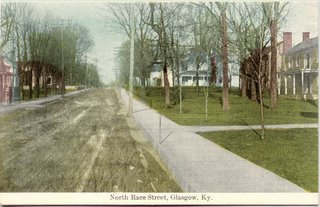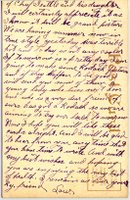 I found this old postcard on some web site a while back. I was so intrigued by it that I couldn't resist spending the couple dollars it took to have it delivered to my mailbox.
I found this old postcard on some web site a while back. I was so intrigued by it that I couldn't resist spending the couple dollars it took to have it delivered to my mailbox.It's not that the scene is remarkable in and of itself—the photo could have been taken in any of hundreds of small American towns—but it's significant to me because of the many times I rode my bike along this very street when I was a kid. It's significant because, despite its familiarity, this scene with its unpaved street, its new sidewalks, and its young trees seems subtly different than the one I knew.
 By the time I was riding along this street, the trees were quite tall, the sidewalks were cracked and uneven, and the street was paved with asphalt.
By the time I was riding along this street, the trees were quite tall, the sidewalks were cracked and uneven, and the street was paved with asphalt.This card was apparently the last of page of a letter, and the cards were probably stuffed in an envelope and mailed that way. As a result, there's no postage stamp and therefore no postmark to give a clue as to the time period. I spent a bit of time with Andrew J. Morris' Postcard Dating Guide, but the about all I learned is that this postcard was likely from somewhere in the 1907-1930 time period.
The author's use of "Kodak" for camera sounds quaint and makes me think of a time before everyone had one. I wonder what she—I think the signature is an abbreviation of Laura—would have thought about today's digital cameras.
Postscripts:
Bringing forward some of the discussion from visitor comments...- According to a representative the Glasgow Electric Plant Board, Glasgow had electricity by 1910; however, he points out that the wires in the postcard image are telephone and telegraph wires, not power lines.
- Postcards from the "divided back era" were produced 1907-1915. These are distinguished from earlier cards with divided backs by the printed words "Post Card" and instructions that specified which half was to be used for correspondence and which was for the recipient's address. There's a nice illustrated discussion of the eras here. The North Race postcard is similar in appearance (if not quality) to some of the ones here.
- The stamp box says "domestic one cent; foreign two cent", which at first seems like a helpful bit of information. But not really. According to Andrew Morris, the cost to mail a post card was one cent from 19 May 1898 - 1 Jan 1952, except for two periods—2 Nov 1917 - 1 Jul 1919 and 15 April 1925 - 30 Jun 1928—when it was temporarily raised to two cents.
- George Eastman introduced his flexible film "Kodak" camera in 1888. Kodak began producing the popular Brownie cameras around 1900.
- Susie made the observation that the postcard's author appears to have been using a dip pen and wondered when the ballpoint pen was invented. According to an article on Wikipedia, the answer is "Laszlo Biro, 1938". Fountain pens began being mass produced in the 1880s. (I actually prefer writing with a good fountain pen over a ballpoint.)
5 comments:
cool, I enlarged it and I think the postage box says domestic 1 cent, foreign 2 cents!
Very good. I saw the same thing and thought it would be a bigger clue than it was. Turns out that with the exception of a couple periods, domestic postage for postcards was one cent from 19 May 1898 - 1 Jan 1952.
This kind of thing gets under my skin, though. I've e-mailed a contact at the electric cooperative in Glasgow to see if there's some historian there who can tell me when the power lines went in along that street. I bet I could get the librarian interested in the problem too (I knew him when I was a kid) if he's still alive and if I can find an e-mail address.
Cool foo! I should read this more often, no? You don't mind if I add you as a friend, do you?
-Spots
Heya, Spots! Add away. I'd be honored.
You know, I started this blog as a result of a thread over on BikeJournal, and yet I think you're the only BJ'er whom I know has stopped by.
Susie: You're quite right about the vintage of the postcard not necessarily reflecting when the photograph was taken. I'm more interested in knowing when that moment in time was captured; however, dating the postcard would help to establish a high limit on the date.
I got a response from the guy at the electric plant board. He said their records don't go back that far, but that electricity had come to town by 1910. However, he also pointed out that the wires in the postcard image are telephone and telegraph wires, and that there are no power lines in evidence.
Regarding the use of "Kodak": I did a bit of Googling before I posted this entry yesterday. Until George Eastman introduced his Kodak camera in 1888, photographic cameras were those big boxy things that used film plates, like you see in the movies. "Kodak" may have been used to distinguish the new cameras that used flexible roll film in the same way that we tend to use "Polaroid" to mean a camera that uses self-developing film.
But the real question would not be "when were Kodaks available?" so much as "when did they become affordable, but not so ubiquitous that every household had one?"
Is this boring yet? This is the kind of history mystery that wraps me up all the time, when I'm in full-blown genealogist mode. I can't always tell when I've driven the exercise into the ground.
I look for postcards like this on eBay all the time. I have three in my collection so far; they're a cool reminder of my childhood.
And all the new things I learned today visiting here. My brain is fried!
Post a Comment